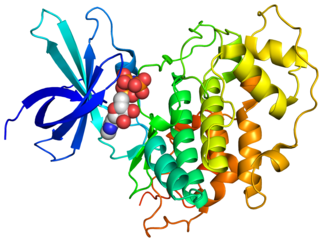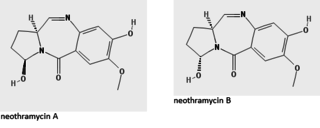
The rifamycins are a group of antibiotics that are synthesized either naturally by the bacterium Amycolatopsis rifamycinica or artificially. They are a subclass of the larger family of ansamycins. Rifamycins are particularly effective against mycobacteria, and are therefore used to treat tuberculosis, leprosy, and mycobacterium avium complex (MAC) infections.

Glycogen synthase kinase 3 (GSK-3) is a serine/threonine protein kinase that mediates the addition of phosphate molecules onto serine and threonine amino acid residues. First discovered in 1980 as a regulatory kinase for its namesake, glycogen synthase (GS), GSK-3 has since been identified as a protein kinase for over 100 different proteins in a variety of different pathways. In mammals, including humans, GSK-3 exists in two isozymes encoded by two homologous genes GSK-3α (GSK3A) and GSK-3β (GSK3B). GSK-3 has been the subject of much research since it has been implicated in a number of diseases, including type 2 diabetes, Alzheimer's disease, inflammation, cancer, addiction and bipolar disorder.

Daunorubicin, also known as daunomycin, is a chemotherapy medication used to treat cancer. Specifically it is used for acute myeloid leukemia (AML), acute lymphoblastic leukemia (ALL), chronic myelogenous leukemia (CML), and Kaposi's sarcoma. It is administered by injection into a vein. A liposomal formulation known as liposomal daunorubicin also exists.

Anthracyclines are a class of drugs used in cancer chemotherapy that are extracted from Streptomyces peucetius bacterium. These compounds are used to treat many cancers, including leukemias, lymphomas, breast, stomach, uterine, ovarian, bladder cancer, and lung cancers. The first anthracycline discovered was daunorubicin, which is produced naturally by Streptomyces peucetius, a species of Actinomycetota. Clinically the most important anthracyclines are doxorubicin, daunorubicin, epirubicin and idarubicin.

Novobiocin, also known as albamycin, is an aminocoumarin antibiotic that is produced by the actinomycete Streptomyces niveus, which has recently been identified as a subjective synonym for S. spheroides a member of the class Actinomycetia. Other aminocoumarin antibiotics include clorobiocin and coumermycin A1. Novobiocin was first reported in the mid-1950s.
Topoisomerase inhibitors are chemical compounds that block the action of topoisomerases, which are broken into two broad subtypes: type I topoisomerases (TopI) and type II topoisomerases (TopII). Topoisomerase plays important roles in cellular reproduction and DNA organization, as they mediate the cleavage of single and double stranded DNA to relax supercoils, untangle catenanes, and condense chromosomes in eukaryotic cells. Topoisomerase inhibitors influence these essential cellular processes. Some topoisomerase inhibitors prevent topoisomerases from performing DNA strand breaks while others, deemed topoisomerase poisons, associate with topoisomerase-DNA complexes and prevent the re-ligation step of the topoisomerase mechanism. These topoisomerase-DNA-inhibitor complexes are cytotoxic agents, as the un-repaired single- and double stranded DNA breaks they cause can lead to apoptosis and cell death. Because of this ability to induce apoptosis, topoisomerase inhibitors have gained interest as therapeutics against infectious and cancerous cells.

Pixantrone is an experimental antineoplastic (anti-cancer) drug, an analogue of mitoxantrone with fewer toxic effects on cardiac tissue. It acts as a topoisomerase II poison and intercalating agent. The code name BBR 2778 refers to pixantrone dimaleate, the actual substance commonly used in clinical trials.

Camptothecin (CPT) is a topoisomerase inhibitor. It was discovered in 1966 by M. E. Wall and M. C. Wani in systematic screening of natural products for anticancer drugs. It was isolated from the bark and stem of Camptotheca acuminata, a tree native to China used in traditional Chinese medicine. It has been used clinically in China for the treatment of gastrointestinal tumors. CPT showed anticancer activity in preliminary clinical trials, especially against breast, ovarian, colon, lung, and stomach cancers. However, it has low solubility and adverse effects have been reported when used therapeutically, so synthetic and medicinal chemists have developed numerous syntheses of camptothecin and various derivatives to increase the benefits of the chemical, with good results. Four CPT analogues have been approved and are used in cancer chemotherapy today: topotecan, irinotecan, belotecan, and trastuzumab deruxtecan. Camptothecin has also been found in other plants including Chonemorpha fragrans.

Indolocarbazoles (ICZs) are a class of compounds that are under current study due to their potential as anti-cancer as well as antimicrobial drugs and the prospective number of derivatives and uses found from the basic backbone alone. First isolated in 1977, a wide range of structures and derivatives have been found or developed throughout the world. Due to the extensive number of structures available, this review will focus on the more important groups here while covering their occurrence, biological activity, biosynthesis, and laboratory synthesis.

Enediynes are organic compounds containing two triple bonds and one double bond.
The duocarmycins are members of a series of related natural products first isolated from Streptomyces bacteria in 1978. They are notable for their extreme cytotoxicity and thus represent a class of exceptionally potent antitumour antibiotics.

Brivanib alaninate (INN/USAN) also known as BMS-582664 is an investigational, anti-tumorigenic drug for oral administration. The drug is being developed by Bristol-Myers Squibb for the treatment of hepatocellular carcinoma or HCC, the most common type of liver cancer. Brivanib is no longer in active development.
Ruthenium anti-cancer drugs are coordination complexes of ruthenium complexes that have anticancer properties. They promise to provide alternatives to platinum-based drugs for anticancer therapy. No ruthenium anti-cancer drug has been commercialized.

Chartreusin is an antibiotic originally isolated from the bacteria Streptomyces Chartreusis. The crystalline compound itself has a yellow-green colour, as per its name, and is stable at room temperature for several hours. Chartreusin is chemically related to elsamitrucin, as the two share an aglycone chartarin structure, though they differ in their sugar moieties. Both chartreusin and elsamitrucin were found to have anticancer activity.

Neothramycin A and B are stereoisomeric antibiotics with anticancer activity. The stereoisomers are interchangeable in aqueous solution and the antibiotic, Neothramycin, contains both in approximately equal amounts. They belong to the pyrrolo(1,4)benzodiazepine, or anthramycin, group which includes other antibiotics such as anthramycin, tomaymycin, and sibiromycin. Neothramycin was originally isolated from Streptomyces No. MC916-C4, a cycloheximide-producing strain, by Umezawa et al. Subsequent testing has shown its capabilities as an anticancer drug, antiprotozoal drug, and even possible uses in DNA fluorescence based assays. Its activities against cancer warranted phase I testing of the drug. More recently, in 1991, anthramycin derivatives, which are very similar to neothramycin, have been investigated for their ability to link DNA when dimerized. These compounds were tested using a fluorescence based assay. These compounds showed an ability to bind dG-containing DNA duplexes with high specificity. This specificity of a DNA crosslinking agent is highly sought after since most are electrophiles and bind indiscriminately. The data collected also showed that pyrrolo(1,4)benzodiazepines can also be used to measure the fluorescence polarization anisotropy on the 0.1-100 ns time scale.

Ellipticine is a tetracyclic alkaloid first extracted from trees of the species Ochrosia elliptica and Rauvolfia sandwicensis, which inhibits the enzyme topoisomerase II via intercalative binding to DNA.

Trodusquemine is an aminosterol that inhibits protein tyrosine phosphatase 1B (PTP1B) activity. The compound exhibits broad-spectrum antimicrobial activity and numerous regenerative, neuroprotective, anti-atherosclerotic, antitumor, antiangiogenic, antiobesity, and anxiolytic properties. Phase I clinical trials of trodusquemine have demonstrated good tolerability, but several planned phase II trials were halted due to financial difficulties of the developer.

C-1027 or lidamycin is an antitumor antibiotic consisting of a complex of an enediyne chromophore and an apoprotein. It shows antibiotic activity against most Gram-positive bacteria. It is one of the most potent cytotoxic molecules known, due to its induction of a higher ratio of DNA double-strand breaks than single-strand breaks.

Shishijimicin A is an enediyne antitumor antibiotic isolated from Didemnum proliferum. Isolated in 2003 it is part of the family of 10 member ringed enediyne antitumor antibiotic agents, which includes: namenamicin, esperamicin and, calicheamicin. Due to its high potency from cytotoxicity, Shishjimicin A is currently undergoing testing as a possible Antibody-antibiotic Conjugate (ADCs) cancer treatment. Laboratory tests indicate it to be “more than 1,000 times as toxic to cancer cells as the anticancer drug taxol”, also known as Paclitaxel, a prevalent chemotherapy medication. As such, theoretically, only an administration of a minuscule dose of the molecule would be necessary per each treatment. As shishjimicin A supply is scarce and the full extent of its side effects is not yet established, there is still a need for further biological and clinical studies.
Fostriecin is a type I polyketide synthase (PKS) derived natural product, originally isolated from the soil bacterium Streptomyces pulveraceus. It belongs to a class of natural products which characteristically contain a phosphate ester, an α,β-unsaturated lactam and a conjugated linear diene or triene chain produced by Streptomyces. This class includes structurally related compounds cytostatin and phoslactomycin. Fostriecin is a known potent and selective inhibitor of protein serine/threonine phosphatases, as well as DNA topoisomerase II. Due to its activity against protein phosphatases PP2A and PP4 which play a vital role in cell growth, cell division, and signal transduction, fostriecin was looked into for its antitumor activity in vivo and showed in vitro activity against leukemia, lung cancer, breast cancer, and ovarian cancer. This activity is thought to be due to PP2A's assumed role in regulating apoptosis of cells by activating cytotoxic T-lymphocytes and natural killer cells involved in tumor surveillance, along with human immunodeficiency virus-1 (HIV-1) transcription and replication.
















